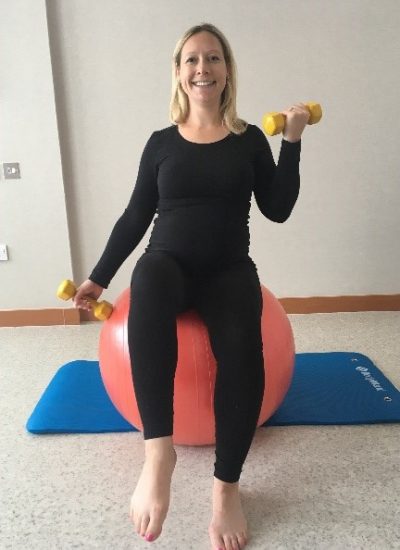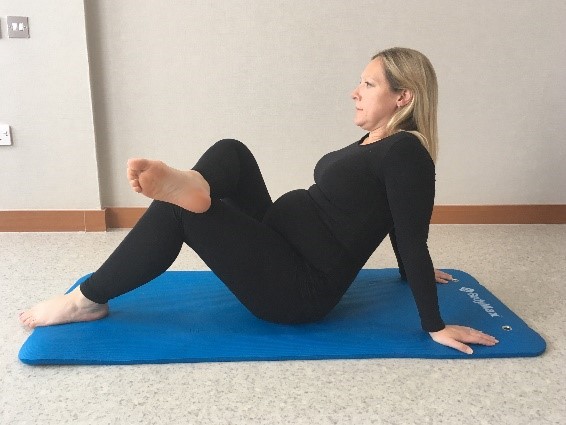Expectant mothers can understandably worry about safely exercising during pregnancy. Doing gentle exercises through pregnancy has been shown to be beneficial for both mum and baby.
Here, we have put together some advice and tips to guide mum’s to be and explain the benefits of doing safe exercises when pregnant. To help you get moving, we’ve included a step-by-step guide to five safe exercises during pregnancy to keep you fit.

What are the benefits of exercising during pregnancy?
Exercise during pregnancy has been shown to have benefits for pregnant women and can reduce the risk of gestational diabetes and preeclampsia. It has also been shown to prevent low back pain, which is common in pregnancy and can affect up to 60% of pregnant women.
Please note: There are certain circumstances in pregnancy where exercise may not be advisable, so make sure you check with your obstetrician or midwife before you start any new exercise.
What kinds of exercises are safe during pregnancy?
If you are new to exercise, build up gently to 30 minutes of moderate exercise daily. The types of exercise recommended are gentle exercise such as:
- Walking
- Swimming
- Stationary cycling
- Modified yoga or Pilates
- Low impact aerobics
Remember, when exercising that you should be able to speak in full sentences and make sure that you drink plenty of water.
During pregnancy, the guidance from the POGP (the pelvic, obstetric, gynaecology physiotherapy association) recommends mild to moderate exercise. The American College of Obstetricians advise that, if you have exercised prior to becoming pregnant, you can continue with your current exercise regime but you may need to make some adaptations, especially as your pregnancy progresses.
Which exercises should be avoided during pregnancy?
Exercises to avoid during pregnancy include:
- High intensity exercise.
- Activities where you might fall (e.g. cycling).
- Activities such as hot yoga.
- Activities where you are lying flat on your back. Remember, after 16 weeks you should not lie flat but should be propped up. If you notice any dizziness, change your position immediately and speak to your healthcare team.
How does pregnancy affect your exercise capacity?
During pregnancy your body changes to adapt for your growing baby and these changes will affect your ability to exercise. There is more blood pumping around your body, this will cause your heart rate to be increased and may affect your blood pressure. Your body also requires more oxygen. Your baby bump grows and pushes your diaphragm up, as a result you may find yourself feeling out of breath more quickly. Exercise intensity needs to be adjusted as a result.
Joints and muscles go through changes in pregnancy. Hormones make your joints more flexible to accommodate the growth of your baby and to prepare your body for birth, and some women can be more prone to experience low back pain and pelvic girdle pain. Exercise has been shown to be beneficial to prevent and treat these, but remember to listen to your body and do exercises which are comfortable.
See below for some examples of simple pregnancy exercises you can do at home. Remember to stop exercising if you have any pain and seek advice from your midwife, obstetrician or specialist physiotherapist.
How to get the most from doing pregnancy exercises at home
- If you have pelvic girdle pain opt for exercises where you aren’t balancing on one leg and seek guidance on the types of exercise you should do.
- Listen to your body and reduce exercise intensity as you feel you need to, exercise at a pace which is comfortable for you (remember speaking in full sentences).
- Exercising in water can be more comfortable for some women.
- Remember to do your pelvic floor exercises (see our blog on the pelvic floor for tips).
A few things to be aware of. Stop exercising and seek advice from your obstetric team if you experience any of the following:
- Vaginal bleeding
- Regular painful contractions
- Increased discharge/fluid leaking
- Breathlessness prior to exercise
- Dizziness or muscle weakness which affects your balance
- Headache
- Chest pain
- Calf pain/swelling
What are the best safe exercises during pregnancy to keep you fit?
To get you started, here are a few gentle, safe exercises to do while pregnant.
IMPORTANT: If you have been experiencing lower back or pelvic pain; it is NOT recommended to perform these exercises. Speak to a Physiotherapist who can advise you on specific exercises for your pregnancy with consideration of your aches/pains.
Exercise 1: Superman (with resistance band option)
- Start on all fours. Place hands directly under shoulders and knees directly under hips. Make sure your spine is straight and lower back is comfortable.
- Engage abdominal muscles by pulling baby up towards you. Keep your balance and extend opposite arm and leg away from you. Hold for a few seconds and keep steady.
- Slowly bring the arm and leg back down to the mat.

As you get stronger, and can do the above comfortably, you can fix a resistance band under your knee. Hold onto it as you extend the arm and the opposite leg behind you (as shown in the photo).
Aim for 3 rounds of 8 repetitions, at least once per week.
Exercise 2: Clam (with resistance band option)
- Start by lying on your side, with feet together and knees bent. Make sure your spine is straight and lower back is comfortable. A pillow just under the bump might be needed.
- Slowly lift/rotate the top knee towards the ceiling, keeping feet/ankles together. Make sure the top hip doesn’t roll back as you perform this exercise. Feel the effort in the buttock muscle of the top leg.
- Hold for a moment, then bring knee back down.

As you get stronger, and can do the above comfortably, you can loop a resistance band and place it around your knees to make it harder. You can also raise your ankles (as shown in the photo) to challenge your balance.
Aim for 3 rounds of 8 repetitions, at least once per week.
Exercise 3: Gluteal/buttock stretch
- Whilst sitting, place one foot on the opposite knee. Relax your lower back and let the knee gently lower towards the floor. Feel the stretch in the buttock.
- Hold for a few seconds.

You can also do this stretch sitting on a chair rather than the floor.
Aim for 5 repetitions, daily.
Exercise 4: Side leg lift (with resistance band option)
- Lay on your side with legs straight. Make sure your spine is straight and lower back is comfortable. A pillow just under the bump might be needed. Raise the top leg to hip height. Feel muscles at the side of the hip working.
- Hold a moment and lower back down again.

As you get stronger, and can do the above comfortably, you can loop a resistance band and place it around your ankles as shown in the photo. This will challenge strength further as you have more resistance to lift the top leg against.
Aim for 3 rounds of 8 repetitions, at least once per week.
Exercise 5: Seated hip lift (with dumbbell option)
- Sit on a gym ball or chair, with your feet firmly on the floor and lower back comfortable. Engage abdominal muscles by pulling baby in towards you. Raise one leg off the floor and feel how this challenges your core muscles.
- Hold a few seconds then lower down. Repeat on the other side.

As you get stronger and can do the above comfortably, you can hold small hand weights (as shown in the photo) or use a bottle of water or tin of beans. As you raise one leg, perform a bicep curl with the opposite arm. This will help to strengthen you across the whole abdominal area.
Aim for 3 rounds of 8 repetitions, at least once per week.
Some thoughts from our yummy mummy to be, Vicky
Vicky, one of our Specialist Orthopaedic Physiotherapists was very active prior to her pregnancy, regularly swimming, cycling and running, as well as teaching Pilates. Vicky tells us how she has had to adapt her exercising during pregnancy.

“In the first trimester I soon realised that my exercise had to take a back seat as nausea and fatigue meant all I could manage was to get through my working day and London commute. On good days I managed some yoga in my front room but I worried that I was loosing my general fitness.
“However, between 12 and 15 weeks my energy began to return and I started enjoying 30 minute walks in the park and short swimming sessions. It was after 15 weeks I found my energy really increased so I could get back into more of a routine. I increased my swimming to 45 minutes and brisk walks to 60 minutes and began exercises using resistance bands and light weights.
“Now in my third trimester I am having to adapt again as I find I fatigue more quickly and get short of breath doing routine tasks that I usually take for granted. I continue to enjoy my swimming and walking but shorter sessions and I now try other simple ways of fitting exercise into my days, like taking the stairs at work. And finally, I have had to modify my yoga and Pilates exercises to accommodate my increasing bump!”
My top tips for exercising during pregnancy would be:
- Listen to your body and self assess how you feel each day because you need to ensure you get a good balance between rest and activity.
- Ask a physiotherapist for advice on modifying your usual exercises or for help with new exercises.
- You can see a physiotherapist if you experience low back pain or pelvic pain for assessment and treatment at any stage during your pregnancy.
Share your tips for safe exercises to do while pregnant
We hope you’ll find our guide to safe exercising during pregnancy helpful. Of course, during a time of so much change, we all have different abilities and capacity to exercise whilst pregnant so we’d love to hear about your own experiences, and tips to help others, in the comments below.
You can also find more information about pregnancy and postnatal care in our Women’s Health Physiotherapy section or feel free to contact us to discuss how we can help make your pregnancy a more comfortable and enjoyable experience for you.





Comments
One Response
I’m not that much of an internet reader to be honest but your blogs really nice, keep it up! I’ll go ahead and bookmark your website to come back down the road.